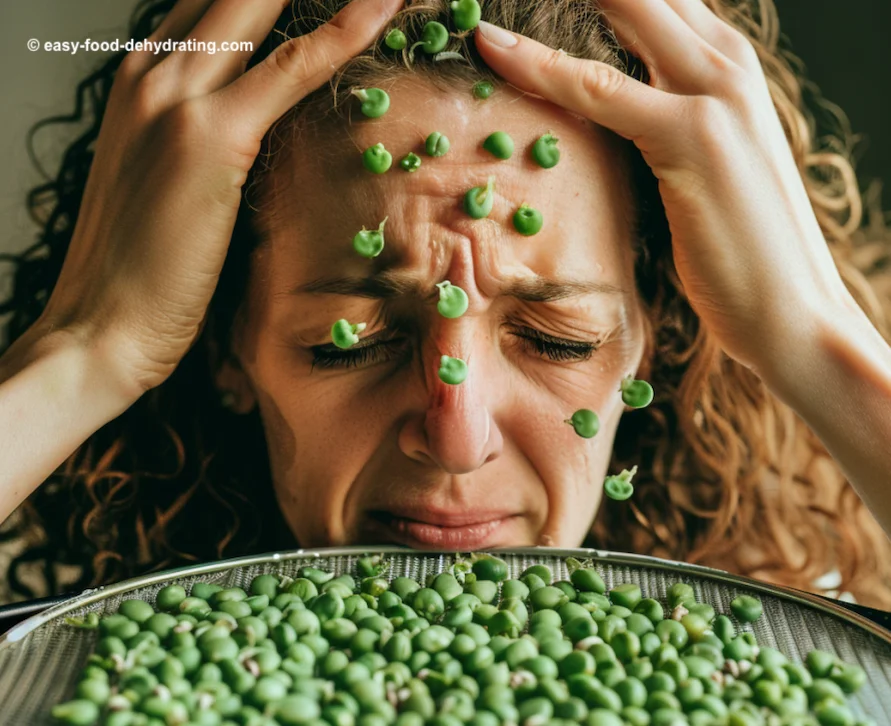- Home
- How To Dehydrate Vegetables
- How To Dehydrate Peas
How to Dehydrate Peas
Peas are One of the Easiest Vegetables to Dehydrate!
by: Susan Gast / Author, Food Dehydrating Fan and Blogger at Beesville Books, and Music Maker SupaBees!
Learning how to dehydrate peas is a great way to preserve them for future use. We can use fresh, or frozen (even canned) peas...

Dehydrating removes the water content from food, leaving behind the dehydrated foods which are great for long- or short-term storage.
Frequently Asked Questions:
Dehydrate peas snack? (Top question!)
Dehydrate peas snack? (Top question!)
Yes, peas make a great snack treat. Read how to dehydrate peas from fresh, frozen, and canned on this page.
What types of peas can be dehydrated?
What types of peas can be dehydrated?
You can dehydrate any type of pea, however, some types are better suited for dehydration than others.
For example, garden peas and snow peas have a higher water content and will not dehydrate as fast as other types such as black-eyed peas or chickpeas that naturally have a lower water content.
Dehydrated peas nutrition?
Dehydrated peas nutrition?
See our "Peas Nutrition Info." section further down this page.
Dehydrator or oven ~ which is best?
Dehydrator or oven ~ which is best?
You can dehydrate peas in a regular oven, but IMHO they are better dried in a dehydrator. If you choose to dehydrate peas in the oven, set the temperature to between 130-140°F and leave them in for about 12 hours.
Check on them occasionally and give them a quick stir to make sure they're not getting overly hot or cooked. When they are done, they should be dry and hard. Store them in an airtight container in a cool, dark place.
Peas are one of the easiest vegetables out there to dehydrate—and even easier if you choose the frozen variety! I love smoothing the peas out on my trays and I use latex gloves - see why later on... so keep reading.

Peas are Super Easy to Dry
Peas are one of the easiest of all vegetables to dry; they rank right up there with corn.
More Information coming up on how to dehydrate peas from frozen.
Check out the "Latex Glove" trick, too - also coming up - for non-stick peas!
Peas Nutrition Info.
VITAMINS: Vitamin A, followed by Vitamin C, Choline, and Niacin. There are trace amounts of Thiamine, Pantothenic Acid, Riboflavin, Vitamin B6, and Vitamin K.
MINERALS: Good source of Potassium, followed by Phosphorus, Magnesium, and Calcium. They also have trace amounts of Iron, Zinc, Manganese, Copper, and Selenium.
Peas contain Omega-3 and Omega-6 fatty acids.
Peas are also a good source of protein and fiber. When dehydrated, they retain most of their nutritional value and are a convenient and easy-to-store snack.
Blanch Fresh Peas Before Dehydrating
There are three kinds and ways to dehydrate peas, either fresh, frozen... or canned.
- Fresh Peas should be blanched before dehydrating as this helps preserve their color and keeps them from dehydrating unevenly.
- Frozen Peas need no extra prep steps! The blanching of the peas was done in the manufacturing facility!
- Canned Peas Canned peas also don't need any extra prep steps. But if you intend to have peas available for long-term food storage, then simply keeping them in their cans is really the way to go.
If you're looking to increase freezer space? Dehydrate frozen peas and then store them in your pantry. No electricity required!

How to Dehydrate FRESH Peas ~ Your First Step
To dehydrate peas properly:
- Start by blanching fresh peas in boiling water for two minutes, as mentioned earlier.
- Remove them from the boiling water and immediately place them into a bowl of ice-cold water.
- After they have cooled, drain them and spread them out on a dehydrator tray.
- Set the dehydrator to 135°F and dry them for 8 to 10 hours.
Use our Fahrenheit to Celsius converter here on our site!
Blanching helps the peas retain their vibrant green color and actually splits their skins. Blanching gives us a shorter drying time.
How to Dehydrate Peas that are Frozen

The image shows my frozen peas all nice and smoothed out on one of my Excalibur dehydrator trays. Yes, Nesco trays are every bit as good!
Please, before dehydrating peas, remember to use the mesh sheets. This stops them from falling through the trays as peas tend to shrivel up quite a bit... and... DRUM ROLL...

BIG TIP...
Use Latex Gloves to Spread Frozen Peas on a Dehydrator Tray
ALERT! Use latex gloves while spreading out the peas on your dehydrator trays. Wearing latex gloves helps stop heat transference, and that means your peas WON'T stick to your HANDS! :-)
Now you can smooth them out on the Excalibur dehydrator or Nesco trays easily.
IMPORTANT: Remember that frozen peas do not need to be blanched before dehydrating. Simply place them on a dehydrator tray and set the temperature at 125°F to 135°F for 8 to 10 hours, or until they are completely dried.
Use our Fahrenheit to Celsius converter here on our site!
Helpful Accessories for a Nesco or Excalibur Dehydrator
I use mesh screens when I'm dehydrating peas to make sure they don't fall through the dehydrator tray openings as they shrivel up when drying.
These screens are readily available where you purchased your dehydrator, and yes, Amazon.com has them!
Nesco ACCESSORIES at Amazon
Nesco LSS-2-6 Round clear plastic 13-1/2" diameter Fruit Roll Sheets, white.
- 2 pk of solid fruit roll sheets
- 1.6 sq feet drying area
- Dry capacity up to 3 cups of pureed fruit per sheet
- Check the red Amazon link to see which Nesco models these Fruit Roll Sheets fit
Nesco LM-2-6 Round plastic mesh 13-1/2" diameter Clean-A-Screens, white.
- 2 pk of mesh sheets
- 1.6 sq feet drying area
- Check the red Amazon link to see which Nesco models these Clean-A-Screens fit
Nesco WT-2SG Round Speckled Plastic 13-1/2" diameter Add-A-Tray.
- 2 pk of speckled round trays
- 1.6 sq feet drying area
- Fits 20 Series and 30 Series Food Dehydrators
- Check the red Amazon link to see all the Nesco models these Add-A-Trays fit
As an Amazon Associate, I earn commission from qualifying purchases. The price you pay does not increase. Read disclosure here.
Excalibur ACCESSORIES at Amazon
Excalibur 14 x 14 inch Fruit Leather Sheets, beige centers and green outer edges.
- 5 pk of solid sheets
- high-grade silicone, excellent non-stick properties
- Check the red Amazon link to see which Excalibur models these Fruit Leather Sheets fit
Lova brand mesh dehydrator sheets for Excalibur Dehydrators, Cosori Dehydrators, Magic Mill Dehydrators, white.
- 6 pk of mesh sheets, can be cut to fit
- high-grade silicone, excellent non-stick properties
- Check the red Amazon link to see which Excalibur models in particular these mesh screens fit
Excalibur 14 x 14 inch Polyscreen Mesh Tray Screen Inserts (black tray NOT included).
- 9 pk of mesh screen inserts/trays
- 100% FDA Food Grade Material
- Check the red Amazon link to see all the Excalibur models these Excalibur-brand mesh tray sheets fit
As an Amazon Associate, I earn commission from qualifying purchases. The price you pay does not increase. Read disclosure here.
When the peas are totally dry, they do reduce a lot in size; that's why I use mesh screens so they don't fall down into the bottom of the dehydrator.
Plus, they help keep your dehydrator clean (just a bit!). Don't skimp on proper cleanliness, though!
In answer to the last question about eating dehydrated peas, I have to add these reminders:
TOOTH ALERT! A warning here about eating dried peas that may be hard: Watch your teeth! I honestly don't eat dehydrated peas. I always rehydrate them (along with other vegetables) for use in soups and other recipes.
Fresh Peas Taste Best... of Course!
If you're lucky and have your own garden, dehydrate fresh peas, obviously!
It pretty much goes without saying that you can use dehydrated peas and other vegetables in soups and stews! (But I said it anyway!)
Velvety Smooth Pea Soup Recipe...
Here's a velvety smooth pea soup recipe for you! It's one of my dad's favorite soups I make - with a simple secret ingredient!
Also, check out our easy-to-make bread here. After all, you need to have something to dip in the soup.
Please visit our recipes page here; the recipes all contain dehydrated foods but fresh ingredients are also listed if you're a member of the free "Grow" club.

Rehydrating Your Dried Peas
When you need to use your dehydrated peas, they can be rehydrated by soaking in water for 30 minutes.
They can be used in any recipe that calls for fresh or frozen peas.
To me, they almost plump back up to their original state. Almost.
How Long Will Dehydrated Peas Last?
Dried peas last for a very long time if stored properly. The key to safe food storage is to make sure foods are completely dry before storing them (and have cooled down to room temperature) before placing them in an airtight container and/or vacuum-sealing them.
If this step is done correctly, peas can last for years.
Tips on How to Dehydrate Peas for Long-Term Food Storage
It's important to read all about food vacuum sealers, what they are, and why you should have AND USE one. Also, don't forget to include a 100cc oxygen absorber inside the vacuum-sealer bag before drawing the air out and then sealing the bag.
Oxygen absorbers contain ingredients that react with one another and draw moisture to them. Learn more about the different-sized oxygen absorbers and their uses.
If you're using Mason jars to store your peas, also include a 100cc oxygen absorber inside your jar of dried peas. Oxygen absorbers are your best friend when dehydrating dried foods.
Keep safe food storage in mind at all times.
Dehydrating Peas for Planting
Drying out peas for planting is a simple process that can be done in a matter of days.
When you are ready to plant, simply soak the peas overnight in water and then plant them in your garden. Peas are hardy plants and will thrive in almost any type of soil. With a little care and attention, you can enjoy a bountiful harvest of fresh peas each and every year.
If you're interested in learning how to grow peas, Common Sense Home has some guidance for you.
Thanks for stopping by to learn how to dehydrate peas.
Don't forget to get your free "Six Simple Steps" eBook where I share how to dehydrate food safely!
Before You Go...
If you like the content, please give me some love by clicking on the 🩷 in the lower right hand corner (on just about all my pages). This signals to me that you find it enjoyable and useful. Thank you so much!



















